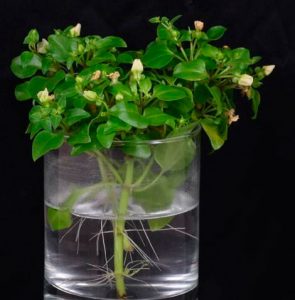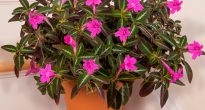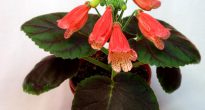Exakum (Exacum) is directly related to the gentian family (Gentianaceae). This genus unites 30 species of not very tall plants. At home, only Exacum affine, which is endemic to Socotra Island in the Indian Ocean, is grown.
The related exacum is a herbaceous plant that branches quite strongly. It is a dense bush that reaches a height of about 30 centimeters. Juicy, erect shoots have short internodes. Short-petiolate leaflets are oppositely located, they have a rhombus shape with smooth edges. In length, they reach 3.5 centimeters. On the surface of the green leaf, 1 central and 2 lateral veins are visible, which are colored in a lighter shade.
The plant blooms for 3-4 months from May to September. Small (15 millimeters in diameter) axillary flowers bloom at the tops of the stems. The flowers are very fragrant and the whole bush is covered with them. A flat corolla with a regular shape, consists of 5 petals, which have an almost round shape. The petals can be painted in different colors depending on the variety, for example, for "Blue Roccet", "Midget Blue", "Blue Eyes" they are bluish, and for "White Star", "Midget White", "Fu¬ji White" - snow-white. There are varieties with purple flowers. All varieties have thick, short anthers of a rich yellow color.
Content
Exakum care at home
This plant growing in natural conditions is a biennial. At home, it is grown as an annual. It is necessary to care for the exakum correctly and provide the necessary conditions for growth, otherwise the flower will not have such a spectacular appearance.
Illumination
He loves light and is not afraid of the direct rays of the sun. But experienced florists recommend shading the flower from the scorching midday direct rays of the sun. Suitable for placement window east, west and south orientation. It is not recommended to place it on the northern window, as in this case flowering may not occur. In the warm season, it would be best to move the plant to fresh air, or even to plant it in open ground in the garden.
Temperature regime
Does not tolerate high temperatures. Feels great at temperatures from 17 to 20 degrees. At higher air temperatures, the flower can be severely damaged.If the weather is hot, then the room where the exakum is located will need to be systematically ventilated, while providing the bush with protection from drafts.
However, the flower is also afraid of the cold. So, it should be transferred to fresh air only after the temperature outside does not drop below 13-15 degrees.
How to water
Water must be systematically and abundantly. The soil should be slightly damp (not wet) at all times. However, make sure that no liquid stagnates in the pot, as this can lead to rotting of the root system and the bases of the juicy shoots.
It is necessary to water with settled water a little warmer than the environment.
Humidity
Needs high humidity. The flower must be systematically moistened with boiled water from a sprayer. Spraying is recommended to be carried out from the seamy side of the foliage in order to avoid liquid getting on the flowers. Water droplets tend to spoil the appearance of the bush, leaving unsightly marks.
Also, to increase the humidity, pebbles or expanded clay must be added to the pallet and a little water must be poured. Or you can put an open container of water next to the flower.
Earth mix
A suitable substrate for planting should be slightly acidic or neutral, as well as allow air and water to pass through well. To prepare the soil mixture, it is necessary to combine humus, leaf, sod and peat soil, as well as coarse sand, taken in equal parts. Purchased universal soil for flowering indoor plants is also suitable.
Flowers are planted in wide, low pots because they have superficial roots. Do not forget to make a good drainage layer at the bottom of the container; broken shards or expanded clay are great for this. To make the bush more lush, it is recommended to plant several exacums in one pot. In flower shops, you can just buy such spectacular bushes.
Fertilizer
They are fed 2 or 3 times every 4 weeks. To do this, use a special fertilizer for flowering plants.
Transplant features
The transplant is not carried out, because the flower needs to be renewed every year.
Pruning
Pruning should not be done because it is already a highly branching plant. However, for long-term abundant flowering, you need to regularly remove wilted flowers.
Reproduction methods
 This flower can be propagated by seeds and cuttings. Seeds are sown in the last weeks of the autumn period. The seeds are simply scattered over the soil surface. The container is covered with glass. After half a month, seedlings appear. Such plants begin to bloom at the age of 5-6 months.
This flower can be propagated by seeds and cuttings. Seeds are sown in the last weeks of the autumn period. The seeds are simply scattered over the soil surface. The container is covered with glass. After half a month, seedlings appear. Such plants begin to bloom at the age of 5-6 months.
For the cutting, you will need to cut off the apical stem, which should have 3 internodes. For rooting, use a glass of water or a substrate consisting of moss and peat. Rooting is fast enough (1.5–2 weeks).
You can also buy a grown plant, which should soon begin to bloom in a special store.
Pests and diseases
Most often it settles on this kind of plants spider mite, aphid or felt. To get rid of aphids and spider mites, you need to thoroughly rinse the flower under a hot (about 45 degrees) shower. Felt must be removed by hand. To do this, take a cotton swab, moisten it in a special liquid insecticidal preparation, and then carefully remove the harmful insect.
The plant is sick most often due to the fact that it is not properly looked after:
- Gray rot - it can appear on the plant due to prolonged stagnation of water in the substrate at low air temperatures.
- Yellow foliage - too abundant watering is also to blame for this.
- Withering of incompletely opened flowers and drying of buds - too low air humidity.













